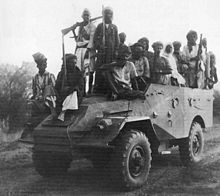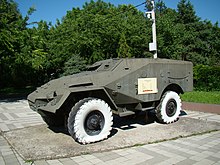|
BTR-40
The BTR-40 (БТР, from Бронетранспортёр, or Bronetransporter, literally "armoured transporter".†) is a Soviet open-topped, wheeled armoured personnel carrier and reconnaissance vehicle.[3] It is often referred to as the Sorokovka in Soviet service.[4] It was eventually replaced in the APC role by the BTR-152 and in the scout car role by the BRDM-1. Development historyThe BTR-40's development began in early 1947 at the design bureau of the Gorky Automobile Factory under the leadership of V. A. Dedkov. The concept was a successor to the BA-64B armoured car which went out of production in 1946. The design team also included L. W. Kostikin and P.I. Muziukin. Two prototypes designated BTR-141 were completed in 1947. The first was armed with two coaxial 14.5 mm KPVT heavy machine guns on a rotatable mount which was protected by armour plate at the front and sides. The second had no fixed armament. Neither one was accepted for service. In 1950 two new prototypes were produced. Those had a different shape of armour including an upright rear armour. Again one prototype had no fixed armament and the second was armed with two coaxial 14.5 mm KPVT heavy machine guns. These were accepted into service as BTR-40 and BTR-40A respectively.[citation needed] The vehicle's drawbacks, such as its poor cross-country performance and problems with crossing water obstacles, compelled the design team to produce, in late 1954, what was planned to be an amphibious variant of the BTR-40. It received the designation BTR-40P (with the 'P' standing for plavayushchiy – "floating"). During the design process, the vehicle moved away from the APC concept and became an amphibious armoured scout car. It received a new designation, BRDM. DescriptionOverviewThe BTR-40's design was based on the GAZ-63 four wheel drive truck which went into production in 1946, using its chassis and most other internal mechanical components, while the six-cylinder engine was based on the design of the GAZ-12 ZIM unit. The design featured a self-bearing body which was a new feature in Soviet vehicles. The hull has two side doors for the commander and driver and a back door. The vehicle can transport up to eight fully equipped soldiers or 1 tonne of cargo. ProtectionThe BTR-40's armour is from 6 mm to 8 mm thick which gives it protection from small arms fire and the shell splinters of its time, but does not protect it against modern artillery fragments and .50-calibre machine gun fire. The BTR-40-series tyres are not protected by armour. They are particularly vulnerable to puncture from fire of all kinds. The vehicle has no roof and is normally covered with a tarpaulin to protect the crew, transported cargo or troops from rain and snow. However this makes it unable to mount any of the SGMB machine guns. ArmamentThe APC variant has no permanent armament but it has pintle mounts for three 7.62 mm SGMB medium machine guns, one at the front of the troop compartment and the other two at the sides. The vehicle also has two firing ports on both sides of the hull which allow up to four soldiers to use their weapons while being protected by the APC's armour. ManeuverabilityLike the GAZ-63 truck on which it is based on, the BTR-40 has a four-wheel drive. The chassis, however, is shorter compared to the GAZ-63. The only other thing that distinguishes the chassis of the BTR-40 from that of the GAZ-63 are additional shock absorbers. The BTR-40 also has a more powerful engine. The turning angle is 7.5 m. EquipmentThe vehicle has the 10RT-12 receiving and airing radio which has a range of 20–25 km and a winch at the front, with a maximum capacity of 4.5 tonnes and 70 m of cable. It has no protection against nuclear, biological and chemical (NBC) weapons. It also has no night vision equipment. Service historySoviet Union The BTR-40 was produced at the Gorkovsky Avtomobilny Zavod (Gorkovsky Automobile Factory) from 1950 to 1960. It was first shown publicly at the military parade in Moscow in 1950. It was issued to the Red Army in 1950 and was used in the APC, reconnaissance and command post roles. After several years of service,[5] it became apparent that it did not fit the modern battlefield. It was replaced by the BTR-152.  Foreign serviceThe BTR-40 began to enter service with two other Warsaw Pact members in late 1949, namely East Germany and Poland, where it was used as a standard APC until more advanced vehicles like the BTR-152 were available. The last BTR-40s were withdrawn from Warsaw Pact countries in the early 1970s. The vehicle was also sold to many Arab and African nations in the late 1950s and early 1960s. The People's Republic of China (PRC), had developed a copy of the BTR-40 called the Type 55. It is unknown how many of these vehicles entered service with the PLA. The vehicle was also exported to North Korea, probably as part of a military assistance programme during the Korean War, where it saw combat for the first time. It was later used by the North Vietnamese Army during the Vietnam War.[6] BTR-40 also saw combat service during the North Yemen Civil War during which at least one was captured from the Egyptians by the royalist guerrillas. List of conflicts
VariantsSoviet Union 
People's Republic of China
Cuba
East Germany
Indonesia
Israel
Operators Current Former  Current operators
Former operators
See alsoReferences
External linksWikimedia Commons has media related to BTR-40. |
||||||||||||||||||||||||||||||||||||||||||||||||||||||||||||||||||||||||
